 |
Flying High With Electric Power!
The Ampeer ON-LINE!
Fly the Future - Fly Electric! |
Site Table of Contents
| President: | Vice-President: | Secretary/Treasurer: |
| Ken Myers | Richard Utkan | Rick Sawicki |
| 1911 Bradshaw Ct. | 240 Cabinet | 5089 Ledgewood Ct. W. |
| Commerce Twp., MI 48390 | Milford, MI 48381 | Commerce Twp., MI 48382 |
| (248) 669-8124 | (248) 685-1705 | 248.685.7056 |
 | ||
| Board of Directors: | Board of Directors: | Ampeer Editor |
| David Stacer | Arthur Deane | Ken Myers |
| 16575 Brookland Blvd. | 21690 Bedford Dr. | 1911 Bradshaw Ct. |
| Northville, MI 48167 | Northville, MI 48167 | Commerce Twp., MI 48390 |
| 248.924.2324 | 248.348.2058 | 248.669.8124 |
| Mailed Ampeer printed subscriptions are no longer available.
The Ampeer is FREE on-line in Acrobat .pdf format and HTML with active links! | ||
| The Next Meeting:
Date: Thursday, February 16 Time: 7:30 p.m. Place: Ken Myers' house, Commerce Twp., MI (see info below) | ||
| What's In This Issue? | |
| Indoor Information Needed, Ken requests more indoor info for the Ampeer. | Indoor RANS S-6ES Coyote, Jeff Kelety shares info and photo of his design. |
| Indoor Info from Canada, Art Lane tells us about the neat indoor planes of FoamStar Models and invites folks to join in in indoor e-flight in London, Ont., Canada. | Information About Kline-Fogleman (KF) Airfoils, link to KF video & Ken provides more info on this type of airfoil. |
| The January 2012 EFO Meeting, Ken Myers started off the meeting with a discussion of the March 2012 edition of Electric Flight and other magazines, Richard Utkan lead off the show and tell with his version of a "Blue Wonder", Hank Wildman showed a Kyosho F-16, Jim Young shared his son's Animal Planet Remote Control Falcon ornithopter, and Ken was notified of the birth of his second granddaughter. | Twins: An 80" PBY Power System, Harvey asks about powering a scratch-built PBY and Ken makes some power system suggestions and also provides info on twins in general. Note: It is best to read this article online as Ken has included extra photos not in the .pdf version and the active links point to important information. |
| Skymasters Ultra Micro Racing, report on this race by Joe Hass. Online version has bonus photos. | |
|
The February meeting will once again be on a THURSDAY, but MUCH LATER in the month. It will be at Ken Myers' house, starting at 7:30. Ken's address is 1911 Bradshaw Ct., Commerce Twp., MI 48390, phone: (248) 669-8124 Everyone with an interest is welcome. See you then! By Ken Myers kmyersefo@theampeer.org Ken, I have had several requests for more information regarding indoor planes and flying from several Ampeer readers. Since I do not fly indoor types, I could use your help and input. Indoor RANS S-6ES Coyote
A link and photo to my holiday offering. I haven't flown the S-6 just yet. I'll do some test taxiing today in the gym but may not fly until I get some calm "over the tall grass" opportunities outdoors.
Cheers,
 Span: 16" Channels: Four: aileron, rudder, elevator, throttle with steerable nose gear Weight: 27g (including 130mAh 3.7v LiPo battery) R/C Gear: Parkzone micro Rx and servos (i.e. from UltraMicro Corsair or T-28) Motor: Geared motor, prop and spinner from Parkzone Mirco Cub Building material: .05" and .025" Durobatics foam and miscellaneous foam block Wing construction: Built up (.05" Durobatics bottom/.025 Durobatics top with airfoil pre-formed by shaping over a rounded desk or tabletop edge) Aileron linkage: Parkzone aileron linkage from T-28 (nose gear linked to aileron horn) Struts: Flattened swizzle sticks from local pub (first purchase gin and tonic Wheels: From Parkzone Vapor
Fuse construction: .05" Durobatics foam sheet sides and bulkheads; top and bottom .025 Durobatics foam sheet
Tail feathers: .05" Durobatics sheet with carbon fiber rod stiffeners
Decals: Lettering and numbering printed on Office Depot Window Decal sheet (Item 212-881) with ink jet printer
Paint: Testors sprays (this is foam safe)
Window trim: Scrap gloss black Monokote trim (circa 1987; never throw away anything!)
Adhesive: Foam safe CA for sandable, external joints (fuse sides, wing leading and trailing edges; UHU Por contact cement for internal joints (bulkheads, wing ribs, etc).
Elapsed build time: About 5 weeks (most of that time spent drinking in pub to collect swizzle sticks for struts)
I wasn't familiar with Durobatics sheet foam. I looked it up on the Internet and found this site.
Indoor Info from Canada
Morning Ken,
Wow, have you done a job on the January issue of Ampeer. I was amazed at the info on props, batteries, and comparisons of Nitro to Electric and especially, the pictures of your last club meeting. "Vely Intelesting," as Shultz would say.
Best Regards,
Information About Kline-Fogleman (KF) Airfoils
James sent a YouTube link for a video with information about this type of airfoil which is commonly used on foam indoor and outdoor models.
And from Ken Myers
Carlos Reyes, in his book RCadvisor's Model Airplane Design Made Easy, has a lot of information on this family of airfoils and its variations starting on p. 56.
|

A couple of KF type airfoils
|
January EFO Meeting The January 5 meeting, at Ken's house, was very well attended. Ken Myers started off the meeting with a discussion of the March 2012 edition of Electric Flight, which he'd received earlier that day. Grumpy Ken noted that it only took him about 20 minutes to read the whole magazine.
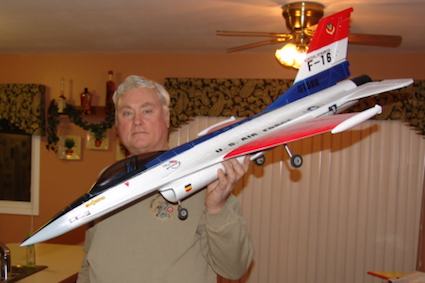 Hank Wildman showed a Kyosho F-16. He'd modified it by adding a 70mm fan unit and retracts. It will be flown on a 4S Li-Poly. 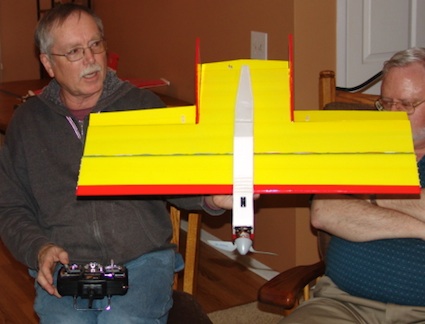 Richard Utkan lead off the show and tell with his version of a "Blue Wonder". It is constructed from Dollar Store foamboard with the cardboard surface removed. That is a technique described in Carlos Reyes' RCadvisor ModiFly book. It uses a KFm2 type airfoil, discussed earlier in this issue. Richard constructed a full fuselage, instead of a profile type, to more closely resemble the Sig Wonder this plane is based on. It features green LED lights on the right wing tip and red on the left. He also demonstrated a unique feature of the Dynam 2.4GHz transmitter he's using with this plane. There is a toggle switch on the top of the transmitter that is used to arm the speed control. Until the switch is toggled, the ESC is inactive. I tried to find a photo of this transmitter online, but couldn't. He got it with his Dynam A-10. 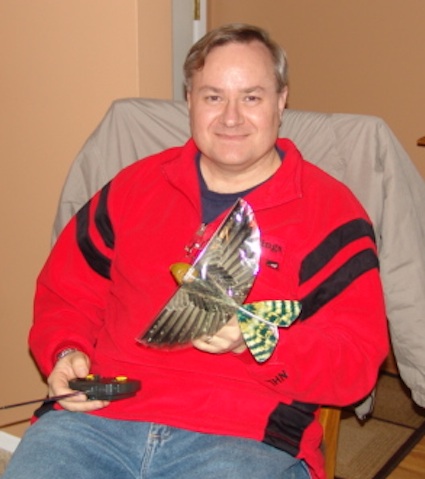 Jim Young brought along his son's Animal Planet Remote Control Falcon ornithopter to share with the group. It is available at Toy R Us. It was a Christmas present to Tim from his grandparents. Jim said that he and Tim have had a chance to fly it at the Ultimate Soccer Arenas and it flies quite well. It didn't do quite as well in Ken's small living room taking out a cup full of peanut M&Ms. There was a general discussion about speed controls and many members noted that they have tried several different "brands", but they have now settled on Castle Creations. Ken noted the excellent service he got on the replacement of his HV-60 and the $22 exchange for his broken Thunderbird 54. Hank Wildman said that he was looking for a new charger, one that was capable of charging "A123" 2300mAh/2500mAh cells. Several folks recommended the FMAdirect CellPro 10S or 10XP. It was suggested that he purchase it from Progressive RC. He was reminded to purchase adapters that match his balance/node connectors. Bill Brown sought advice on purchasing motors for his proposed Wright Flyer "B". Jim Young had drawn up plans for it that were shared at the December meeting. Ken and Jim Young looked up the specifications for the Dualsky XM2812RTR-33 and thought that it might be useful. It has the ESC built into the motor. It has a Kv of 1470 RPM/v and is rated for 70 watts in. It weighs 25.7g. The members decided to move the monthly meeting to the third Thursday of the month. About 9:00, Ken received a call from his son, Donovan. His newest granddaughter, Ever, had entered the world. Mom, Somer, and baby, Ever, were doing fine. Of course Ken announced the exciting news to all present. What a great night. Remember that anyone with an interest is always welcome at EFO meetings. Hope to see you at the February 16, 7:30 p.m. meeting at Ken Myers' house in Commerce Twp., MI. Twins: An 80" PBY Power System
Hello Mr. Myers, I hope that you can help me out?
Best wishes for 2012 and thank you,
I wanted to know more about whether Harvey had the skills and knowledge to actually achieve a successful build and replied: Hi Harvey, I could use a bit more information on your model.
Thanks,
The answers to those preliminary questions would help me to decide what the ready to fly weight might be and what the wing cube loading (WCL) might be. The more scale, and the more options like retractable landing gear and retractable tip floats, the heavier the finished model will be. Harvey replied: Hi Ken, Thank you for your reply.
Thank you and best regards,
When I replied again, I wanted to make sure that Harvey knew what type of project he was in for. Hi Harvey, It looks like your estimate of twin glow 50s is in the ballpark. Unfortunately, there is no direct relationship to glow and electric power. The glow motor is chosen for the prop size it can turn, and not necessarily the power of the given internal combustion engine.
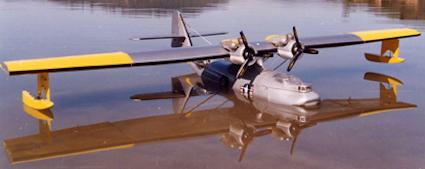 I found this similar size PBY online. It confirms the glow engine size, as well as the proposed weight. Adding options like retractable gear and tip floats adds to the complexity and weight. You should read through this article, Charging Into Electric Flight: A Primer from the Master, by my flying buddy Keith Shaw. In it he states, under the heading: THE FOUR KEYS TO SUCCESS: "When approaching a new challenge such as electric flight, a carefully considered plan of action will minimize frustration and maximize results. First, set an achievable goal with several measured steps to reach it. If your dream is to fly an electric B-17 or a WWII fighter and you are presently flying a basic glow-powered trainer, there will be many steps! Don't expect to learn everything at once. Even if you have well-developed flying skills, I would still recommend starting with a sport electric plane just to get used to the technology of charging Ni-Cd (short for nickel-cadmium) batteries, maintaining electric motors, optimizing prop selection and building structures appropriate to the task. Even after flying R/C for over 30 years, I still build "test-bed trainers" to check out an unconventional aerodynamic layout or bizarre configuration. These test-bed aircraft have the desired configuration, size, wing area and power system but use simple structures and no "fancies" such as retracts. I practice flying the test-bed until I'm comfortable with it, then start ballasting it up to what a serious version might weigh. This way, I'm not fighting all the battles at once" I would also suggest that you download and read his article on designing RC planes. Even though you have plans, sometimes they are not done well and lead to problems that can be avoided with Keith's advice. The article is formatted in four linked Acrobat .pdf files. www.theampeer.org/shaw/SHAW1.PDF
It sounds like you are an excellent modeler. You'll most likely be able to complete a successful build of this aircraft.
Later,
Since I have NEVER created a twin, I did a lot of research on the Internet to assist me in recommending a power system for Harvey's PBY. What I learned amazed me!
I gathered plane data for past and present glow and electric powered twins. It is presented in the table. |
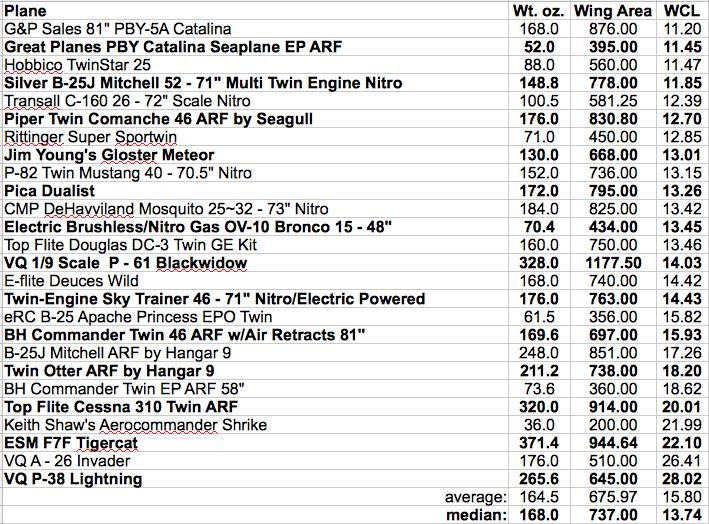
Twin Table
|
I found the wing cube loadings (WCL) very interesting. Remember that the WCL is a good indicator of the "fly-ability" of the model and the piloting skill required to fly the plane successfully. The WCL Levels - a review
The WCLs for twins indicate that an above average, experienced pilot, skilled at flying heavily loaded models is required to fly the majority of twins.
 1.) De Havilland DH-84 Dragon-2, RC electric scale 94.7" wingspan, 232 oz., 1700 sq.in. and a WCL of 5.72 oz./cu.ft. The biplane configuration and the modeler's building skill and technique contributed to the lower WCL of this plane, which should fly like a big "Park Flyer".' 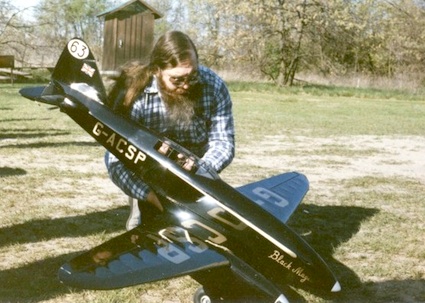 2.) Keith Shaw's DeHavilland Comet w/28 Nicads, 136 oz., 900 sq.in. with a WCL of 8.70 oz./cu.ft. Keith's extraordinary design and build skills contributed to the relatively low WCL sport-like flying capability of this plane, except for the sharply tapered wing plan form that keeps the pilot's attention!  The fourth example, based on my experience and research, just cannot be correct.  The median WCL for twins is 13.75 oz./cu.ft. If that is used to set the target ready to fly (RTF) weight for the proposed PBY, then 800 sq.in. / 144 sq.in. = 5.56 sq.ft. ^ 1.5 = 13.1 cu.ft. * 13.75 oz./cu.ft. = 180.125 oz. or 11.25 pounds.
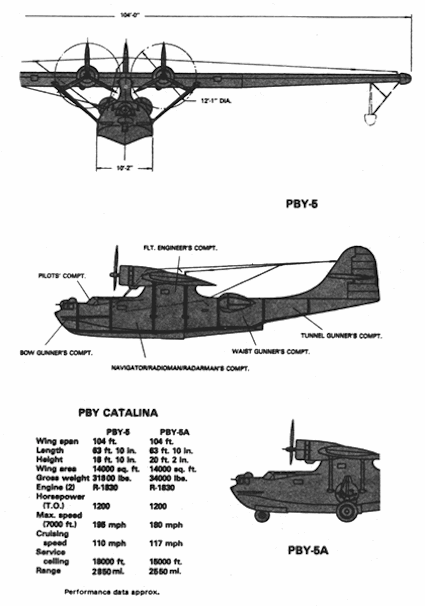 A 3-view drawing that I found on the Internet indicated that the largest possible diameter prop(s) would be 10". The PBY could use 3-blade props. I have no experience with 3-blade props. I remembered that when Lucien Miller of Innov8tive Designs, added the Cobra line of motors, he tested Master Airscrew 3-blade props. I know that for a motor to handle 565 watts in, it should weigh between 565 watts in / 3 g of motor weight per watt in = 188g to 565 watts in / 1.75 g per watt in = 323g. I started by checking the Cobra motors for their weights. The Cobra C-3510 series weighs about 141g, too light. The Cobra C-3515 series about 178g, too light. The Cobra C-3520 series about 216g. That should be okay because 565 watts in / 216g = 2.62 watts in per gram of motor weight. I started with the highest Kv Cobra 3520 outrunner, which was the 980 Kv motor. I checked the prop chart and found that there were no 10" MAS 3-blade props that required about 565 watts in. I did notice that the APC 10x5E and the MAS 10x5x3 pulled about the same watts in and amps and the APC 10x7E and MAS 10x7x3 were pretty close in amp draw and watts in with the APC being 6% or 7% less. Next I looked at the 820Kv motor. I found that at 18.5v (5S Li-Poly) the MAS 10x5x3 was just about right. 30.16 amps, 558 watts in, 12,388 RPM, 58.7 mph pitch speed, 85.08 oz. thrust Generically, outside diameter in mm, length in mm (NOT shaft length), dash Kv and comma followed by weight in grams, it is a 4346-820, 216g motor. The generic motor name allows easy substitution. For example the Tower Hobbies Rimfire .32, generically is a 4250-800, 198g. The 2 Dog RC Dualsky XM4250CA-6 is a 4250-840, 200g. The Turnigy 4258 is a 4251-800, 265g. The Head's Up RC Power Up 32 Sport is a 4243-800, 212g motor. Before selecting the battery and ESCs, in case the power needed to be increased, I checked the Innov8tive Designs prop chart for the Cobra C3520-12 motor and found the data for the MAS 10x7x3 at 18.5v, 42.36 amps, 784 watts in, 11,516 RPM, 76.3 mph pitch speed, 102.29 oz. thrust A 42 amp draw per motor, for practical purposes, eliminates one large 5S1P 8400mAh battery. It would be almost impossible to find. Combining two 4200mAh Li-Poly packs in parallel, to become a 5S2P 8400mAh, pack would work and is probably the best option. The MAS 10x5x3 should pull between 60 amps and 70 amps from the 5S2P battery when both motors are running at full throttle through both ESCs. If the MAS 10x7x3 is used, the amp draw from the battery might be 80 to 90 amps. Since each ESC and motor is only seeing half of the amp draw, and allowing for the MAS 10x7x3 pulling up to 50 amps near the beginning of the pack discharge, a 50 amps * 1.25 (the inverse of 80%) = 62.5 amp speed control would be a good choice. Castle Creations Phoenix ICE or ICE Lite 75-amp ESCs, would allow plenty of safety margin if going to a bigger prop pitch was necessary. The ICE or ICE Lite 50 would be fine, if the MAS 10x5x3 or APC 10x5E were sufficient. 1.) What would be the motor sizes recommended?
2.) Would it be wise to have 2 power packs with 2 speed controllers for the motors and a 3rd power pack for the servos and transponder?
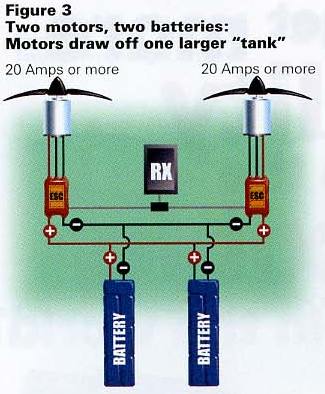 You may chose to either use the built-in switching battery eliminator circuit (BEC) of one of the Castle Creations ICE ESCs to power the receiver and servos, or use a separate switching BEC, or use a receiver pack, such as a 2-cell A123 2300mAh pack. A power meter MUST be used to check that the power system is operating at the expected levels and not exceeding the maximum amp ratings of any of the components. The system may be checked as a whole, or the two individual motors and ESCs tested separately with the power meter inline with one 5S 4200mAh Li-Poly battery. Here is a YouTube video on twin wiring. I am sure the Ampeer readers would be very interested in the rest of the build and the flying of the model. Skymasters Ultra Micro Racing
Our Ultra Micro Racing was a complete success with 32 pilots flying 20 races in 2 categories (Polecat and Warbird) in about 90 minutes. 16 year old Danny Craig easily won the Polecat races, followed by Paul Zabawa, Sean Fidler and John Hoover. Bill Klems won the warbird class, followed by Tom Andras, Mark Ugo and Les Baron.
 Six╩foot folding tables, laid flat on the artificial turf, formed the takeoff runways. Decorative cones from the Red Bull racing series formed the course. The "Race For All The Marbles" (see below) with a young buck challenging a seasoned veteran started with a bit of a challenge from Tracy Hoover between Chris Hass (the young buck) and John Hoover (the seasoned veteran). After one false start the race was on. John had the lead until he cut a pylon. After 4 laps Chris was the winner. They continued flying, first demonstrating some close formation flying. Then John remained upright while Chris flew the course inverted. Then Chris flew the course continuously rolling. The difference in speed was amazing. Chris finished by hovering a Polecat in front of the crowd. Chris also demonstrated the new small Model Aero Polaris (our featured speaker on January 25 at Larson) and an ETOC routine. I flew the Model Aero Stinger (a very neat, easy to build aircraft). 1st through 3rd place received a specially created Retro R/C Wallet preloaded with some cash. There were pilot's prizes for all the flyers and plenty of prizes for the spectators and helpers. Two entrants drove over 90 miles to participate. Given the number of requests for a date for the next race I think we have a winner in this format. My sincere thanks to all who helped us with the races. It would not have been so successful without you. Thanks to John Hoover and Chris Hass for the initial idea. Thanks to Jim Held and Fred Engelman for the continued ideas, brainstorming and creativity. Thanks to George Maiorana for the idea to use tables for "takeoff runways". 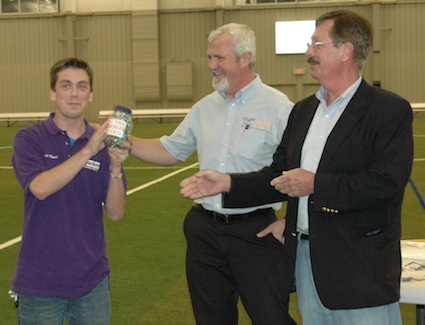 "All The Marbles" is a coveted award, made up the night before (it is very hard to find marbles at 9PM) Hellman's mayonnaise jar filled with marbles and a shiny ALL THE MARBLES AWARD label. 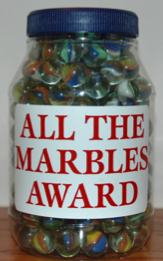 Special thanks for their generous support to:
|
To Reach Ken Myers, you can land mail to the address at the top of the page. My E-mail
address is:
kmyersefo@theampeer.org
EFO WEB site: http://www.theampeer.org
